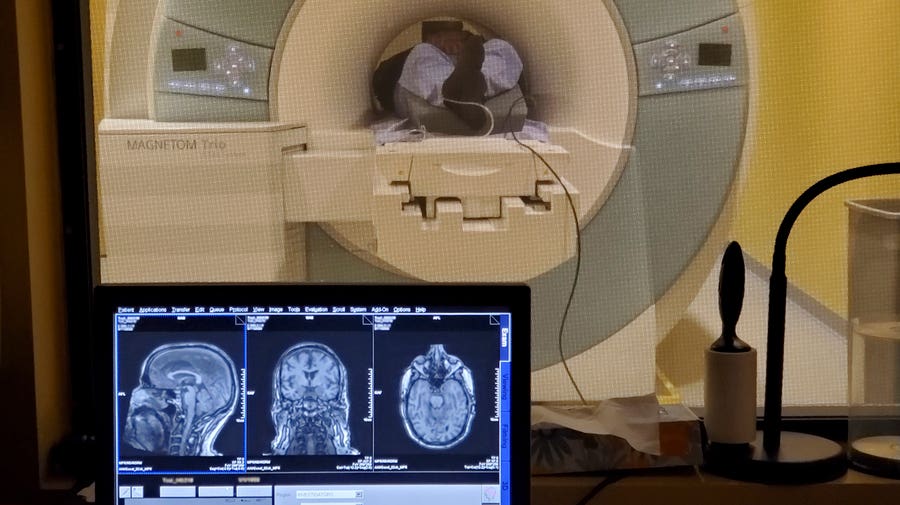New study finds 40Hz sensory stimulation may benefit some Alzheimer’s patients for years
MIT researchers report two-year results showing 40 Hz light and sound therapy may slow Alzheimer’s progression safely.

 Edited By: Joseph Shavit
Edited By: Joseph Shavit

Researchers at the Picower Institute are exploring whether stimulating the brain’s natural 40-hertz “gamma” rhythm can slow or reverse Alzheimer’s disease. (CREDIT: David Orenstein/Picower Institute)
A gentle flicker of light and a steady hum of sound might help slow the course of Alzheimer’s disease. That’s the idea behind a novel therapy developed by researchers at the Massachusetts Institute of Technology and Massachusetts General Hospital, who report encouraging two-year results from a small but groundbreaking study.
The treatment, called gamma entrainment using sensory stimulation—or GENUS—uses synchronized light and sound pulsing at 40 hertz, a frequency that seems to restore brain rhythms disrupted by Alzheimer’s. Over two years, five patients with mild Alzheimer’s used the device for an hour each day in their homes.
The study, led by Dr. Diane Chan and Dr. Li-Huei Tsai, found that the therapy was safe, well-tolerated, and appeared to help preserve memory and cognitive function, especially in those with late-onset Alzheimer’s disease.
Reawakening the Brain’s Rhythm
Healthy brains naturally produce gamma waves—electrical oscillations that support memory, focus, and sensory processing. In people with Alzheimer’s, these waves become weaker and more irregular, disrupting communication between brain cells. Earlier animal studies from MIT showed that restoring those rhythms using flickering light and sound could reduce amyloid and tau buildup, two key proteins that drive Alzheimer’s progression.
Building on those findings, the GENUS device emits light and sound synchronized at 40 hertz. This pattern “entrains” the brain, coaxing it to follow the same rhythm. The latest open-label extension study followed five participants—three women with late-onset Alzheimer’s and two men with early-onset forms—for about 30 months. It’s the longest human test of this approach to date.
Each participant used a home setup consisting of an LED light panel, a speaker, and a tablet that displayed entertainment content while delivering the rhythmic stimulation. Researchers tracked brain activity using EEG, measured brain structure with MRI, recorded sleep patterns with wrist monitors, and analyzed blood samples for Alzheimer’s biomarkers such as phosphorylated tau 217.
A Clear Signal in the Brain
All participants showed 40 Hz brain activity during stimulation, confirming that the therapy was successfully engaging neural circuits. Over time, the response stayed stable—or even strengthened—in the three late-onset participants. In one case, the entrainment strength increased by more than 160 percent.
The two early-onset participants, however, showed a gradual decline in their 40 Hz brain response, hinting that the therapy may be less effective for that form of the disease.
The entrainment effect was strongest in the visual processing regions of the brain, reinforcing that light plays a major role in synchronizing the neural rhythm.
Better Sleep and Stable Thinking
Sleep disruption is one of the most distressing symptoms of Alzheimer’s. Using activity-tracking devices, the researchers found that four of the five participants experienced steadier daily sleep-wake cycles after beginning gamma stimulation. Their rest patterns became more consistent, and daytime alertness improved in some cases.
Cognitive testing also pointed to meaningful benefits—particularly among those with late-onset Alzheimer’s. Using standard clinical assessments such as the Mini-Mental State Examination (MMSE) and the Clinical Dementia Rating (CDR), the researchers observed slower or halted cognitive decline compared with matched patient data from national Alzheimer’s databases. Statistical analyses showed that the differences were significant, with p-values between 0.01 and 0.02.
The two participants with early-onset Alzheimer’s did not experience measurable improvement. Their test scores tended to follow expected decline rates, mirroring their weaker EEG responses. Because early-onset Alzheimer’s often progresses more rapidly and affects wider brain networks, researchers suspect the disease’s biology may limit how well the brain can synchronize to external rhythms.
Signs of Biological Change
MRI scans showed that, while brain volume loss continued over the two years, late-onset participants lost less tissue than would typically be expected. More striking were the changes seen in blood biomarkers.
Two late-onset participants who provided blood samples had dramatic drops in phosphorylated tau 217 levels—by 47 percent and 19 percent, respectively. This protein strongly correlates with the buildup of tangles in the brain, one of Alzheimer’s defining features. No previous non-invasive therapy has shown such a reduction in human patients.
“These results suggest that GENUS could have direct biological impacts on Alzheimer’s pathology,” the authors wrote in Alzheimer’s & Dementia: The Journal of the Alzheimer’s Association.
Safe and Feasible at Home
No serious side effects were reported throughout the study. Minor issues like brief tiredness or restlessness faded early on. Every participant completed the two-year program, a rare feat in long-term dementia research. The ability to receive therapy while watching TV or reading likely boosted compliance and comfort.
The researchers noted that the open-label nature of the study—meaning everyone knew they were receiving the real treatment—makes it harder to rule out placebo effects. However, they compared the results to thousands of Alzheimer’s cases from major national databases, strengthening their confidence in the findings.
The contrasting outcomes between early- and late-onset Alzheimer’s may reflect deeper biological differences. Early-onset forms tend to damage more brain regions, including those tied to vision and attention. They also progress more quickly and may interfere with gamma oscillations in ways the GENUS therapy can’t easily repair. Another variable is that all late-onset participants were women, while both early-onset participants were men—raising questions about whether hormonal or genetic factors might influence the therapy’s success.
A Path Toward Larger Trials
The research team, supported by the Freedom Together Foundation, the Belfer Family Foundation, the Dolby Family, and others, emphasizes that more work is needed. The small sample size limits the strength of the conclusions, but the consistent improvements seen in late-onset participants provide a strong reason to continue. Larger, randomized controlled trials are already underway through MIT spinout Cognito Therapeutics.
Dr. Chan, the study’s lead author, said the goal now is to determine who benefits most from this therapy. “Future research should explore predictors of treatment response, such as genetic and pathological markers,” she explained.
Dr. Tsai, who directs MIT’s Aging Brain Initiative, echoed that optimism, noting that sensory stimulation could become a safe, affordable complement to drug-based treatments. “Long-term 40 Hz audiovisual stimulation is safe, feasible, and may offer cognitive and biomarker benefits,” she said.
Practical Implications of the Research
If future trials confirm these early results, GENUS could redefine how Alzheimer’s is treated. The idea that light and sound alone might slow brain degeneration offers hope for millions of families seeking non-drug therapies.
Because the system can be used at home, it could make treatment more accessible and less intimidating than clinical interventions.
In the long term, gamma stimulation may even help delay disease onset if used preventatively—a question the MIT team is now exploring in older adults at risk for Alzheimer’s.
Research findings are available online in the journal Alzheimer s & Dementia.
Related Stories
- Obesity accelerates Alzheimer’s-linked plaque buildup in the brain
- Breakthrough therapy found to substantially benefit Alzheimer's patients, MIT study finds
- Meet microglia: The brain's secret weapon against Alzheimer's
Like these kind of feel good stories? Get The Brighter Side of News' newsletter.
Rebecca Shavit
Science & Technology Journalist | Innovation Storyteller
Based in Los Angeles, Rebecca Shavit is a dedicated science and technology journalist who writes for The Brighter Side of News, an online publication committed to highlighting positive and transformative stories from around the world. With a passion for uncovering groundbreaking discoveries and innovations, she brings to light the scientific advancements shaping a better future. Her reporting spans a wide range of topics, from cutting-edge medical breakthroughs and artificial intelligence to green technology and space exploration. With a keen ability to translate complex concepts into engaging and accessible stories, she makes science and innovation relatable to a broad audience.



